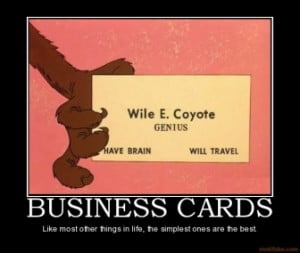A writer wants their words to be memorable, but there’s another item they want everyone to notice…their business card.
Your name, email address, photo and website are sufficient introductory information. Experts argue if you really need to add your writing genre. If your website has links to your Facebook fan page, Pinterest page and Twitter feed, there is no need to include those items on your card. Likewise, your home address and phone number are superfluous.
When designing your own calling card, keep in mind your primary objective. There are three types of literary business cards: trade, personal and marketing.
Trade business cards are best for self-published authors or freelance writers. These could include email address and website, so potential clients can contact you for jobs.
Personal business cards work for authors linked to a traditional publishing house, where they want name recognition. These are perfect for networking with readers and other writers. This card should contain information about you, not your books. Social media links could also be included on a personal card.
Marketing business cards focus on the product you are promoting, rather than the genre or author. This type of card is for each successive book you produce and market.
A photo helps people remember you. However, make sure it’s a head-shot only. You may have a fabulous body, but a business card is no place to flaunt it.
Lauren Ruth, literary agent of Slush Pile Tales, throws away generic business cards she receives from authors. The types she keeps are the ones with the author’s photo and a printed pitch on the back of the card. “I knew exactly who this author was,” she said.
You may want to include the main tagline from your pitch on the front of your business card. “Non-preachy inspirational fiction” and “quirky small-town romance” might be two fun examples.
Vista Print is usually the first place new writers go for business cards. They have tons of choices and bargain-basement prices. A simple set of 500 is under $25. Staples.com is having a sale right now, 250 full-color, matte finish business cards for $20 (regularly $30), with free shipping. Other printers are Zazzle.com, Uprinting.com and Printrunner.com.
A template makes designing your own business card a snap. Most printers have several to choose from, depending on your needs. Once you have decided on a style for your card, color and content can be addressed. Simple, but memorable, are the watch words.
Who should you give these fabulous communication creations to? Everyone! Friends, family and acquaintances can share your business cards with people they know. Fellow writers meet industry professionals all the time. They might remember you would be a perfect fit for a certain agent or publisher. The networking ripples could extend beyond the whole literary pond.
“If you can’t write your idea on the back of my calling card, you don’t have a clear idea. “–David Belasco, the Bishop of Broadway
Credits: Author Business Cards, Lauren Ruth, from www.slushpiletales.wordpress.com; The Best Business Cards for Creative Writers, Jennifer Stone, from www.ehow.com; Author Business Cards are Different, Jennifer Hudson Taylor, from www.jenniferswriting.blogspot.com.


Very informative. Thanks for writing this.
Thanks for your comment, Donna! I appreciate the support.